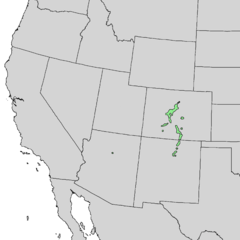Pinus aristata
| Pinus aristata | |
|---|---|
 | |
| Scientific classification | |
| Kingdom: | Plantae |
| Division: | Pinophyta |
| Class: | Pinopsida |
| Order: | Pinales |
| Family: | Pinaceae |
| Genus: | Pinus |
| Subgenus: | Ducampopinus |
| Species: | P. aristata |
| Binomial name | |
| Pinus aristata Engelm. | |
 | |
Pinus aristata, the Rocky Mountain bristlecone pine, is a species of pine native to the United States. It appears in the Rocky Mountains in Colorado and northern New Mexico, with an isolated population in the San Francisco Peaks in Arizona. It is usually found at very high altitudes, from 2500–3700 m, in cold, dry subalpine climate conditions, often at the tree line, although it also forms extensive closed-canopy stands at somewhat lower elevations.
Description

Pinus aristata is a medium-size tree, reaching 5–15 m tall and with a trunk diameter of up to 1.5 m. The bark is grey-brown, thin and scaly at the base of the trunk. The leaves ('needles') are in fascicles of five, stout, 2.5–4 cm long, deep green to blue-green on the outer face, with stomata confined to a bright white band on the inner surfaces. The cones are ovoid-cylindrical, 5–10 cm long and 3–4 cm broad when closed, purple at first, ripening yellow-buff when 16 months old, with numerous thin, fragile scales, each scale with a bristle-like spine 4–8 mm long.
The cones open to 4–6 cm broad when mature, releasing the seeds immediately after opening. The seeds are 5 mm long, with a 10–20 mm wing; they are mostly dispersed by the wind, but some are also dispersed by Clark's Nutcrackers, which pluck the seeds out of the opening cones. The nutcrackers use the seeds as a food resource, storing many for later use, and some of these stored seeds are not used and are able to grow into new plants.
It differs most conspicuously from the two other bristlecone pine species in that the needles usually have only one, (only rarely two) resin canals, and these are commonly interrupted and broken, leading to highly characteristic small white resin flecks appearing on the needles. This character, which looks a bit like 'dandruff' on the needles, is diagnostic of Pinus aristata; no other pine shows it (though sometimes, scale insect infestations can look superficially similar).
It is a long-lived tree, though not attaining the longevity of Pinus longaeva. The oldest known tree, which grows high on Black Mountain in Colorado, was found to have at 2,435-year tree ring record (and overall estimated age of 2,480 years, per Craig Brunstein) in 1992.[1] However, trees rarely live over 1,500 years.
This species was previously described as a subspecies of Pinus balfouriana (Pinus balfouriana aristata). Pinus aristata is currently regarded as one of three closely related species known as bristlecone pines and is sometimes named as the Rocky Mountains, or Colorado, bristlecone pine . In addition to its informal and regional names, the trees are referred to as the bristlecone, foxtail or hickory pine.
Cultivation
Pinus aristata is by far the most common of the bristlecone pines in cultivation, where it is a very attractive slow-growing small tree suitable for small gardens in cold climates. Even so, it is never as long-lived as in the wild, typically living less than 100 years before it succumbs to root decay in the warmer, moister conditions prevalent in most inhabited places.
References and external links
| Wikimedia Commons has media related to Pinus aristata. |
- Conifer Specialist Group (1998). Pinus aristata. 2006. IUCN Red List of Threatened Species. IUCN 2006. www.iucnredlist.org. Retrieved on 11 May 2006.
- Gymnosperm Database: Pinus aristata
- Flora of North America: Pinus aristata
- High-elevation white pine educational website: Pinus aristata
- HikeArizona.COM Images: Pinus aristata
- Photo of cone (scroll to bottom of page)
- USDA Plants Profile: Pinus aristata
